Corporate Accounting: Lessor's Accounting for Different Leases
VerifiedAdded on 2021/06/17
|5
|1261
|46
Report
AI Summary
This report provides a comprehensive overview of corporate accounting for leases, focusing on the perspective of the lessor. It begins by defining leases and classifying them into financial and operating leases. The report then details the accounting treatment for each type of lease, including revenue recognition, cost of sale, and profit or loss calculations for financial leases, and rental income recognition and expense allocation for operating leases. It also addresses specific considerations for manufacturer or dealer lessors, such as interest rate adjustments and cost recognition. The report also covers disclosure requirements, including the presentation of maturing receivables and asset classifications. The report concludes by emphasizing the importance of adhering to accounting standards in the treatment and disclosure of lease information.
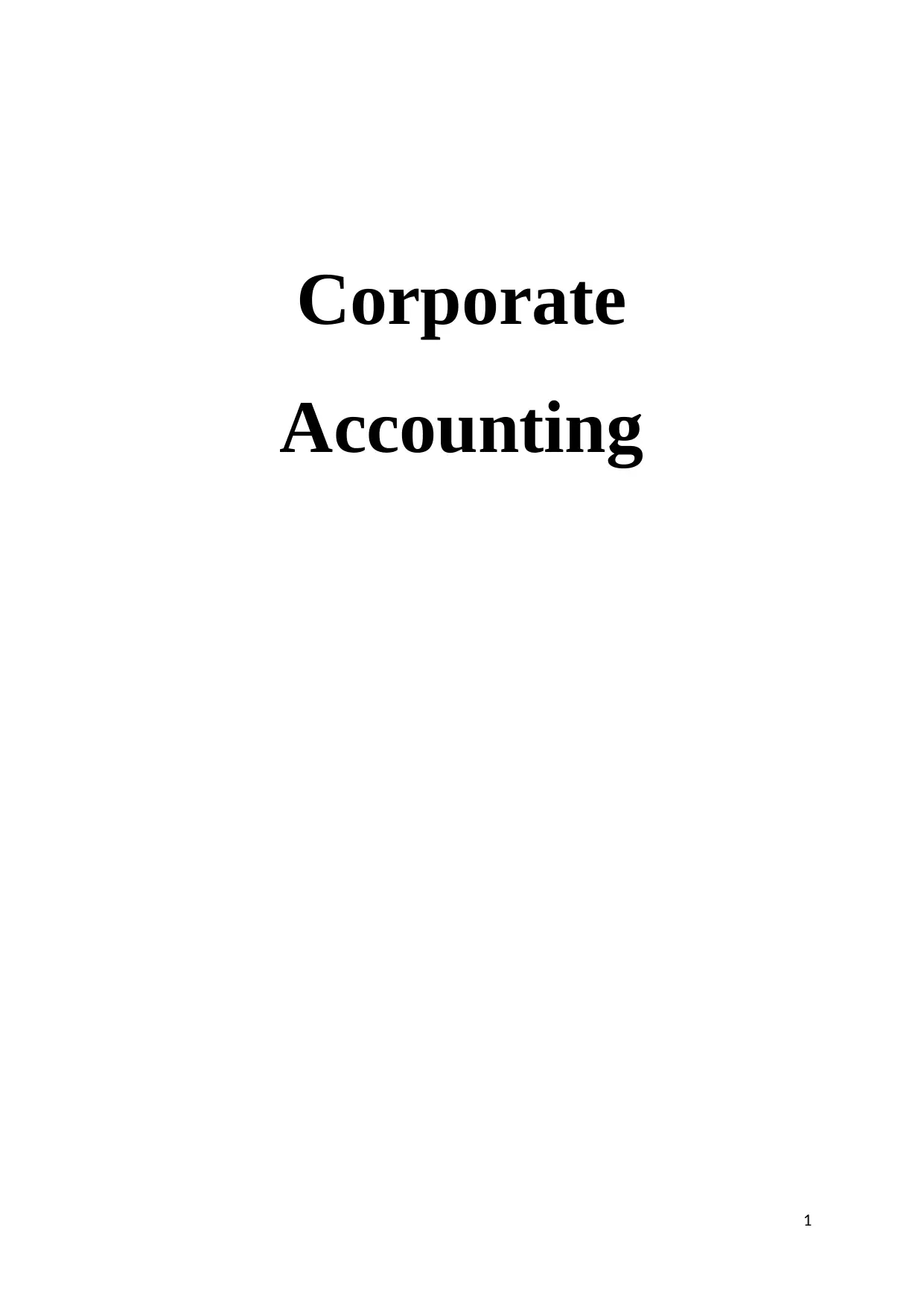
Corporate
Accounting
1
Accounting
1
Paraphrase This Document
Need a fresh take? Get an instant paraphrase of this document with our AI Paraphraser
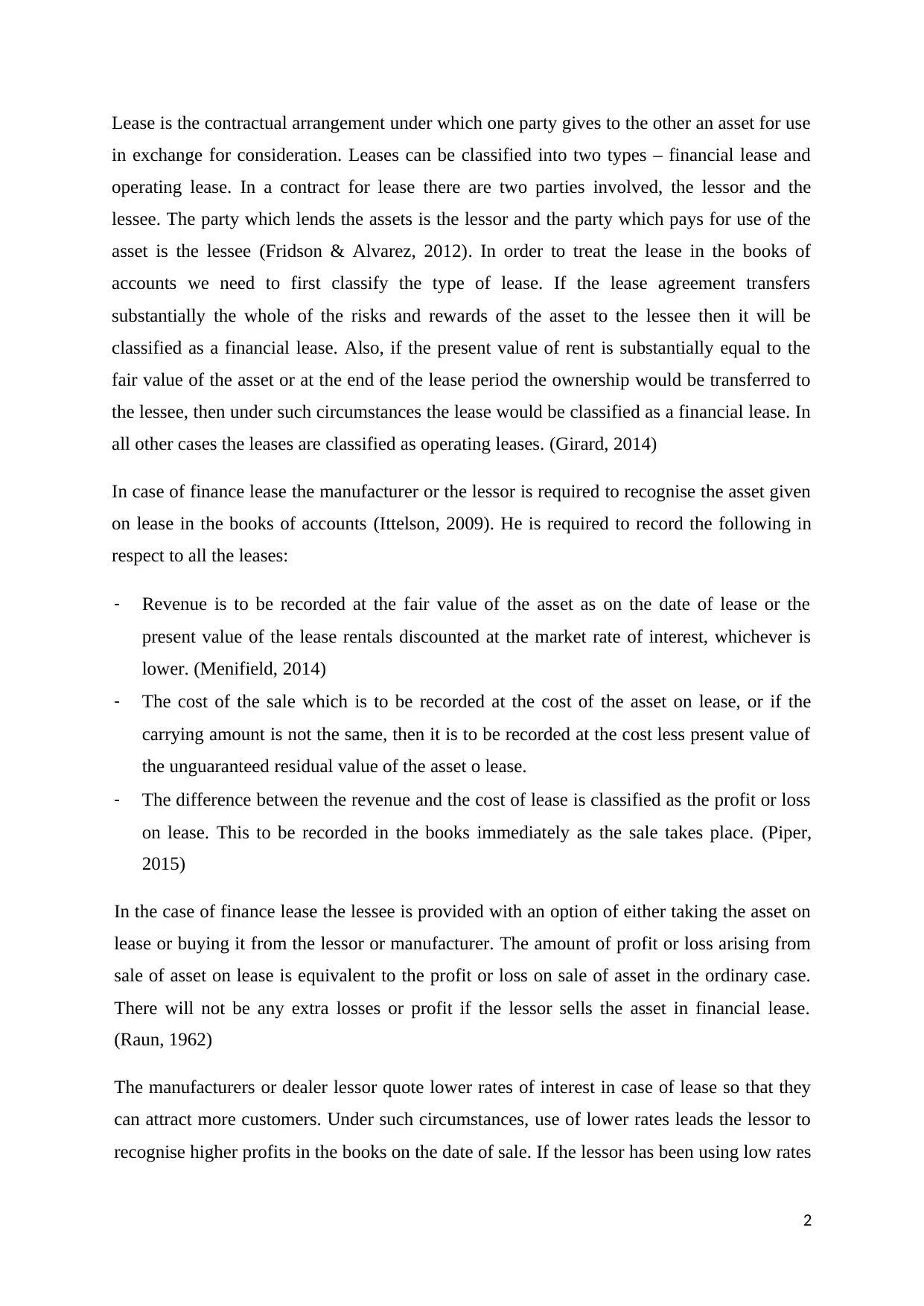
Lease is the contractual arrangement under which one party gives to the other an asset for use
in exchange for consideration. Leases can be classified into two types – financial lease and
operating lease. In a contract for lease there are two parties involved, the lessor and the
lessee. The party which lends the assets is the lessor and the party which pays for use of the
asset is the lessee (Fridson & Alvarez, 2012). In order to treat the lease in the books of
accounts we need to first classify the type of lease. If the lease agreement transfers
substantially the whole of the risks and rewards of the asset to the lessee then it will be
classified as a financial lease. Also, if the present value of rent is substantially equal to the
fair value of the asset or at the end of the lease period the ownership would be transferred to
the lessee, then under such circumstances the lease would be classified as a financial lease. In
all other cases the leases are classified as operating leases. (Girard, 2014)
In case of finance lease the manufacturer or the lessor is required to recognise the asset given
on lease in the books of accounts (Ittelson, 2009). He is required to record the following in
respect to all the leases:
- Revenue is to be recorded at the fair value of the asset as on the date of lease or the
present value of the lease rentals discounted at the market rate of interest, whichever is
lower. (Menifield, 2014)
- The cost of the sale which is to be recorded at the cost of the asset on lease, or if the
carrying amount is not the same, then it is to be recorded at the cost less present value of
the unguaranteed residual value of the asset o lease.
- The difference between the revenue and the cost of lease is classified as the profit or loss
on lease. This to be recorded in the books immediately as the sale takes place. (Piper,
2015)
In the case of finance lease the lessee is provided with an option of either taking the asset on
lease or buying it from the lessor or manufacturer. The amount of profit or loss arising from
sale of asset on lease is equivalent to the profit or loss on sale of asset in the ordinary case.
There will not be any extra losses or profit if the lessor sells the asset in financial lease.
(Raun, 1962)
The manufacturers or dealer lessor quote lower rates of interest in case of lease so that they
can attract more customers. Under such circumstances, use of lower rates leads the lessor to
recognise higher profits in the books on the date of sale. If the lessor has been using low rates
2
in exchange for consideration. Leases can be classified into two types – financial lease and
operating lease. In a contract for lease there are two parties involved, the lessor and the
lessee. The party which lends the assets is the lessor and the party which pays for use of the
asset is the lessee (Fridson & Alvarez, 2012). In order to treat the lease in the books of
accounts we need to first classify the type of lease. If the lease agreement transfers
substantially the whole of the risks and rewards of the asset to the lessee then it will be
classified as a financial lease. Also, if the present value of rent is substantially equal to the
fair value of the asset or at the end of the lease period the ownership would be transferred to
the lessee, then under such circumstances the lease would be classified as a financial lease. In
all other cases the leases are classified as operating leases. (Girard, 2014)
In case of finance lease the manufacturer or the lessor is required to recognise the asset given
on lease in the books of accounts (Ittelson, 2009). He is required to record the following in
respect to all the leases:
- Revenue is to be recorded at the fair value of the asset as on the date of lease or the
present value of the lease rentals discounted at the market rate of interest, whichever is
lower. (Menifield, 2014)
- The cost of the sale which is to be recorded at the cost of the asset on lease, or if the
carrying amount is not the same, then it is to be recorded at the cost less present value of
the unguaranteed residual value of the asset o lease.
- The difference between the revenue and the cost of lease is classified as the profit or loss
on lease. This to be recorded in the books immediately as the sale takes place. (Piper,
2015)
In the case of finance lease the lessee is provided with an option of either taking the asset on
lease or buying it from the lessor or manufacturer. The amount of profit or loss arising from
sale of asset on lease is equivalent to the profit or loss on sale of asset in the ordinary case.
There will not be any extra losses or profit if the lessor sells the asset in financial lease.
(Raun, 1962)
The manufacturers or dealer lessor quote lower rates of interest in case of lease so that they
can attract more customers. Under such circumstances, use of lower rates leads the lessor to
recognise higher profits in the books on the date of sale. If the lessor has been using low rates
2
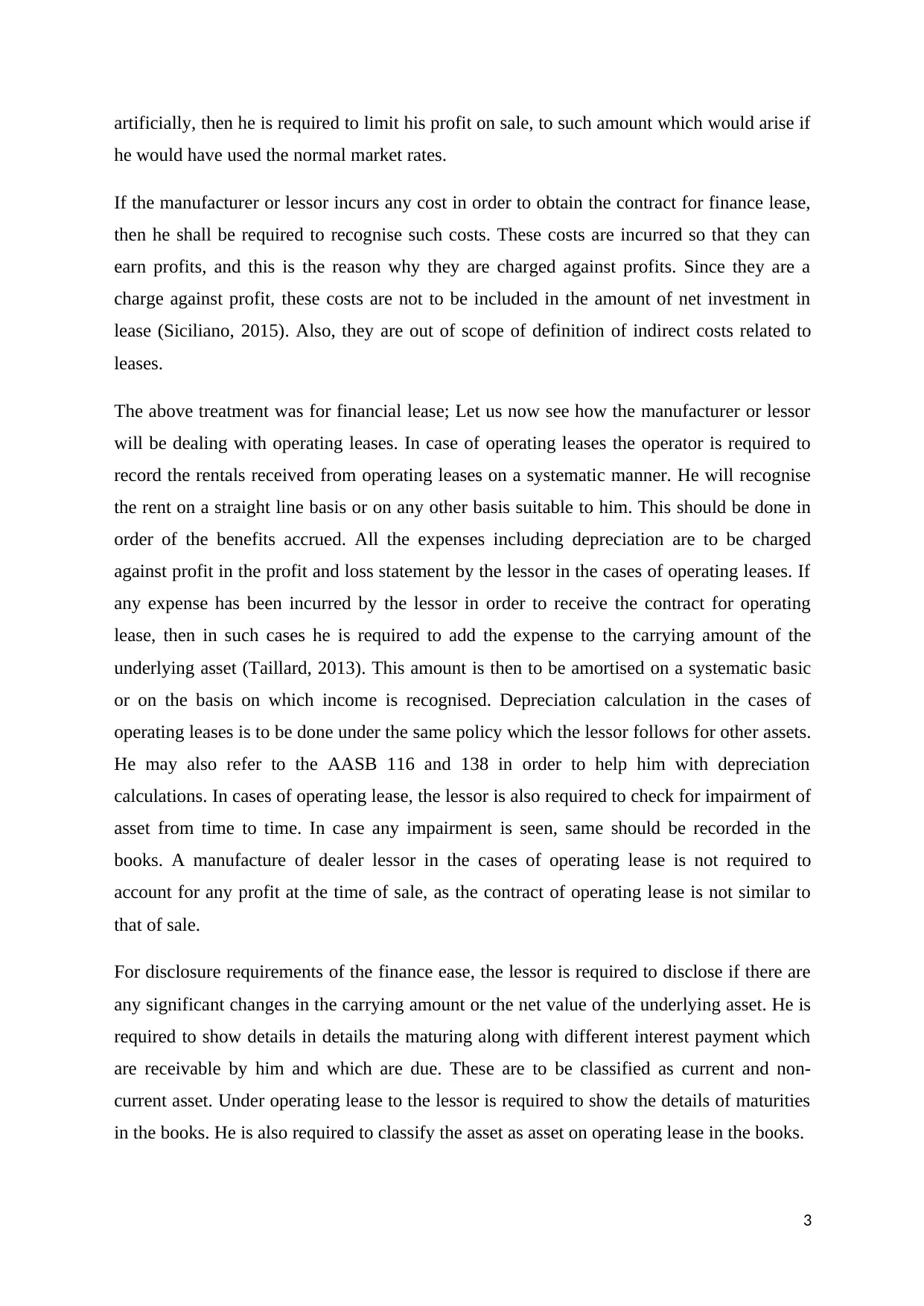
artificially, then he is required to limit his profit on sale, to such amount which would arise if
he would have used the normal market rates.
If the manufacturer or lessor incurs any cost in order to obtain the contract for finance lease,
then he shall be required to recognise such costs. These costs are incurred so that they can
earn profits, and this is the reason why they are charged against profits. Since they are a
charge against profit, these costs are not to be included in the amount of net investment in
lease (Siciliano, 2015). Also, they are out of scope of definition of indirect costs related to
leases.
The above treatment was for financial lease; Let us now see how the manufacturer or lessor
will be dealing with operating leases. In case of operating leases the operator is required to
record the rentals received from operating leases on a systematic manner. He will recognise
the rent on a straight line basis or on any other basis suitable to him. This should be done in
order of the benefits accrued. All the expenses including depreciation are to be charged
against profit in the profit and loss statement by the lessor in the cases of operating leases. If
any expense has been incurred by the lessor in order to receive the contract for operating
lease, then in such cases he is required to add the expense to the carrying amount of the
underlying asset (Taillard, 2013). This amount is then to be amortised on a systematic basic
or on the basis on which income is recognised. Depreciation calculation in the cases of
operating leases is to be done under the same policy which the lessor follows for other assets.
He may also refer to the AASB 116 and 138 in order to help him with depreciation
calculations. In cases of operating lease, the lessor is also required to check for impairment of
asset from time to time. In case any impairment is seen, same should be recorded in the
books. A manufacture of dealer lessor in the cases of operating lease is not required to
account for any profit at the time of sale, as the contract of operating lease is not similar to
that of sale.
For disclosure requirements of the finance ease, the lessor is required to disclose if there are
any significant changes in the carrying amount or the net value of the underlying asset. He is
required to show details in details the maturing along with different interest payment which
are receivable by him and which are due. These are to be classified as current and non-
current asset. Under operating lease to the lessor is required to show the details of maturities
in the books. He is also required to classify the asset as asset on operating lease in the books.
3
he would have used the normal market rates.
If the manufacturer or lessor incurs any cost in order to obtain the contract for finance lease,
then he shall be required to recognise such costs. These costs are incurred so that they can
earn profits, and this is the reason why they are charged against profits. Since they are a
charge against profit, these costs are not to be included in the amount of net investment in
lease (Siciliano, 2015). Also, they are out of scope of definition of indirect costs related to
leases.
The above treatment was for financial lease; Let us now see how the manufacturer or lessor
will be dealing with operating leases. In case of operating leases the operator is required to
record the rentals received from operating leases on a systematic manner. He will recognise
the rent on a straight line basis or on any other basis suitable to him. This should be done in
order of the benefits accrued. All the expenses including depreciation are to be charged
against profit in the profit and loss statement by the lessor in the cases of operating leases. If
any expense has been incurred by the lessor in order to receive the contract for operating
lease, then in such cases he is required to add the expense to the carrying amount of the
underlying asset (Taillard, 2013). This amount is then to be amortised on a systematic basic
or on the basis on which income is recognised. Depreciation calculation in the cases of
operating leases is to be done under the same policy which the lessor follows for other assets.
He may also refer to the AASB 116 and 138 in order to help him with depreciation
calculations. In cases of operating lease, the lessor is also required to check for impairment of
asset from time to time. In case any impairment is seen, same should be recorded in the
books. A manufacture of dealer lessor in the cases of operating lease is not required to
account for any profit at the time of sale, as the contract of operating lease is not similar to
that of sale.
For disclosure requirements of the finance ease, the lessor is required to disclose if there are
any significant changes in the carrying amount or the net value of the underlying asset. He is
required to show details in details the maturing along with different interest payment which
are receivable by him and which are due. These are to be classified as current and non-
current asset. Under operating lease to the lessor is required to show the details of maturities
in the books. He is also required to classify the asset as asset on operating lease in the books.
3
⊘ This is a preview!⊘
Do you want full access?
Subscribe today to unlock all pages.

Trusted by 1+ million students worldwide
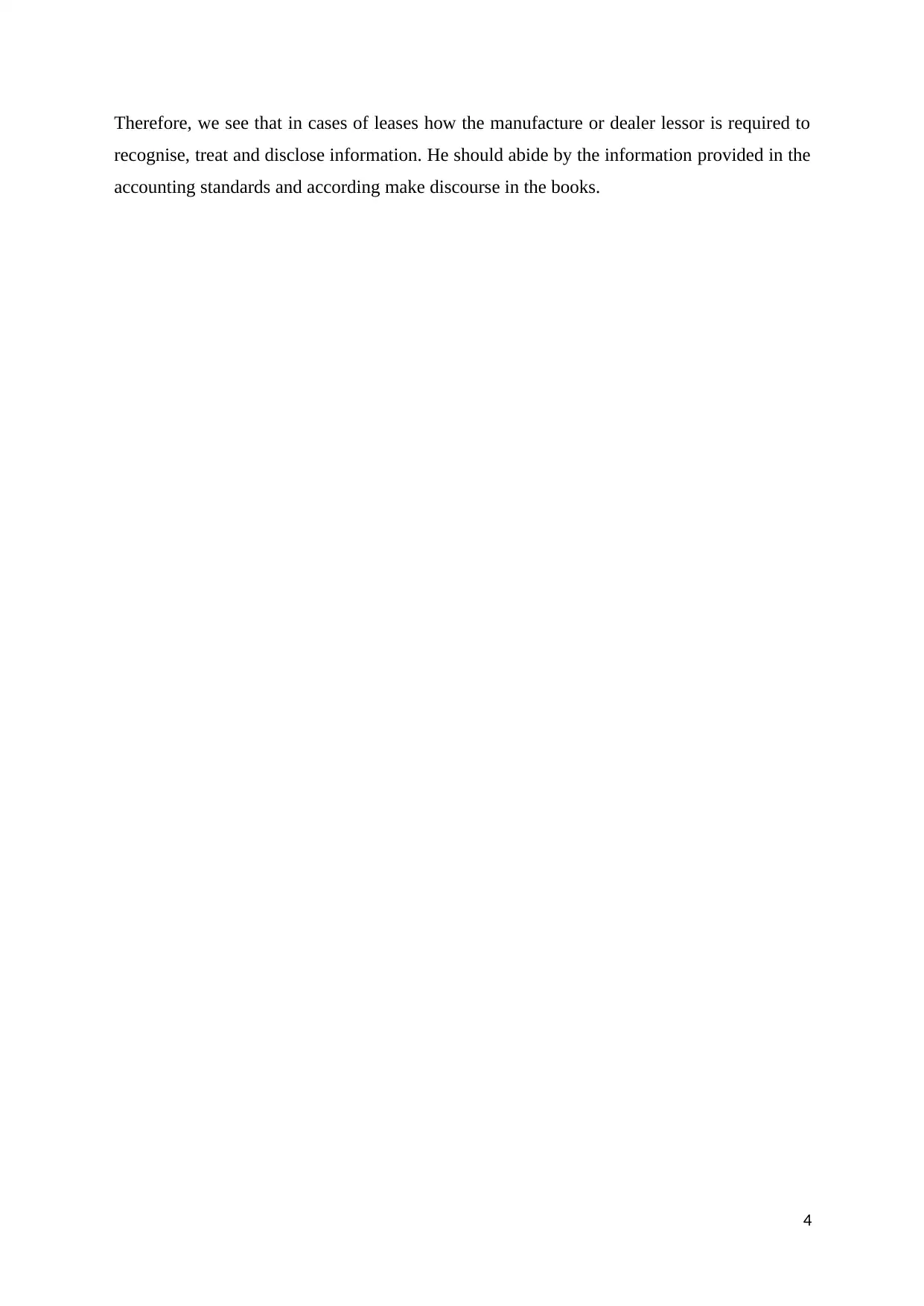
Therefore, we see that in cases of leases how the manufacture or dealer lessor is required to
recognise, treat and disclose information. He should abide by the information provided in the
accounting standards and according make discourse in the books.
4
recognise, treat and disclose information. He should abide by the information provided in the
accounting standards and according make discourse in the books.
4
Paraphrase This Document
Need a fresh take? Get an instant paraphrase of this document with our AI Paraphraser
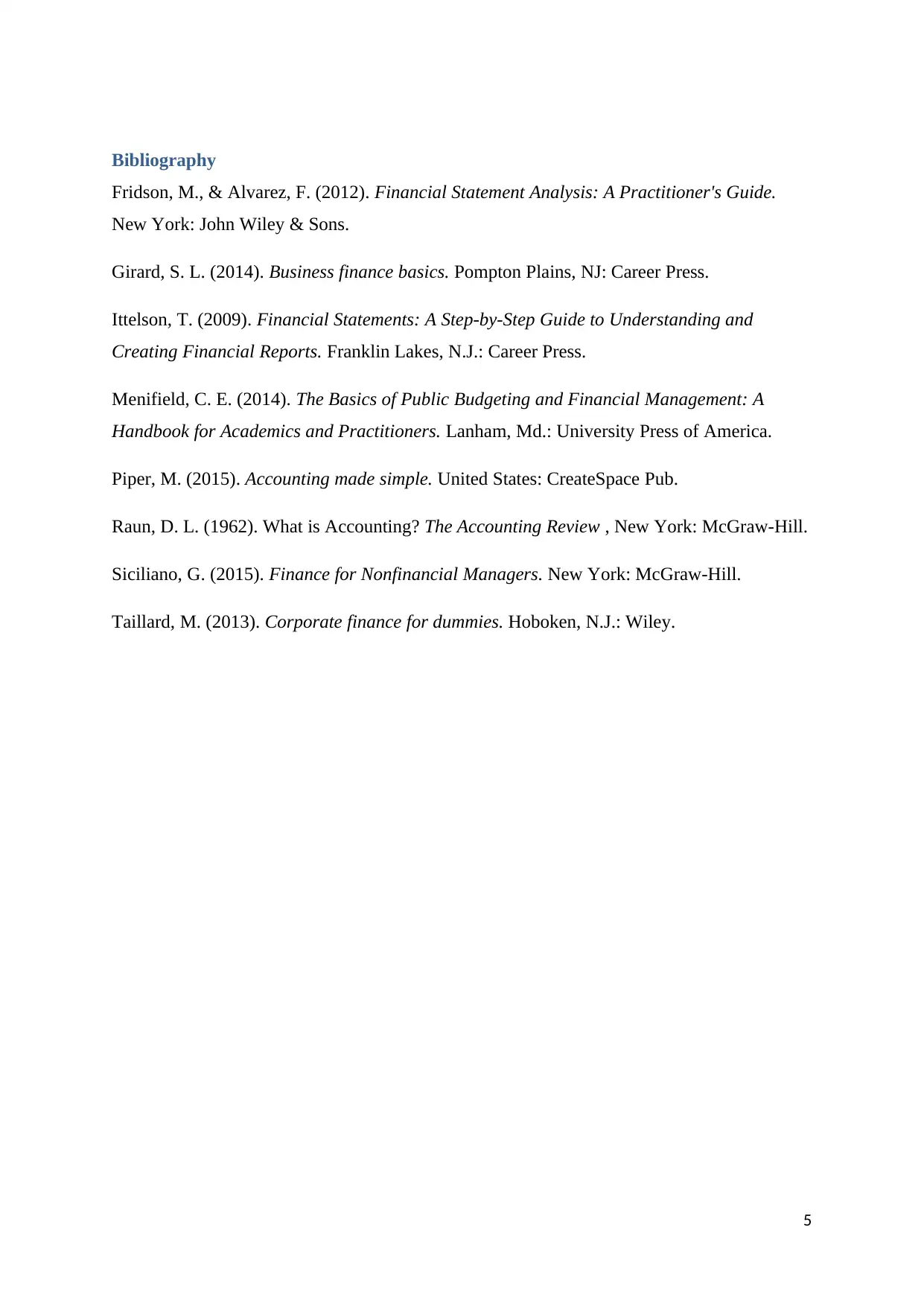
Bibliography
Fridson, M., & Alvarez, F. (2012). Financial Statement Analysis: A Practitioner's Guide.
New York: John Wiley & Sons.
Girard, S. L. (2014). Business finance basics. Pompton Plains, NJ: Career Press.
Ittelson, T. (2009). Financial Statements: A Step-by-Step Guide to Understanding and
Creating Financial Reports. Franklin Lakes, N.J.: Career Press.
Menifield, C. E. (2014). The Basics of Public Budgeting and Financial Management: A
Handbook for Academics and Practitioners. Lanham, Md.: University Press of America.
Piper, M. (2015). Accounting made simple. United States: CreateSpace Pub.
Raun, D. L. (1962). What is Accounting? The Accounting Review , New York: McGraw-Hill.
Siciliano, G. (2015). Finance for Nonfinancial Managers. New York: McGraw-Hill.
Taillard, M. (2013). Corporate finance for dummies. Hoboken, N.J.: Wiley.
5
Fridson, M., & Alvarez, F. (2012). Financial Statement Analysis: A Practitioner's Guide.
New York: John Wiley & Sons.
Girard, S. L. (2014). Business finance basics. Pompton Plains, NJ: Career Press.
Ittelson, T. (2009). Financial Statements: A Step-by-Step Guide to Understanding and
Creating Financial Reports. Franklin Lakes, N.J.: Career Press.
Menifield, C. E. (2014). The Basics of Public Budgeting and Financial Management: A
Handbook for Academics and Practitioners. Lanham, Md.: University Press of America.
Piper, M. (2015). Accounting made simple. United States: CreateSpace Pub.
Raun, D. L. (1962). What is Accounting? The Accounting Review , New York: McGraw-Hill.
Siciliano, G. (2015). Finance for Nonfinancial Managers. New York: McGraw-Hill.
Taillard, M. (2013). Corporate finance for dummies. Hoboken, N.J.: Wiley.
5
1 out of 5
Related Documents
Your All-in-One AI-Powered Toolkit for Academic Success.
+13062052269
info@desklib.com
Available 24*7 on WhatsApp / Email
![[object Object]](/_next/static/media/star-bottom.7253800d.svg)
Unlock your academic potential
Copyright © 2020–2025 A2Z Services. All Rights Reserved. Developed and managed by ZUCOL.




